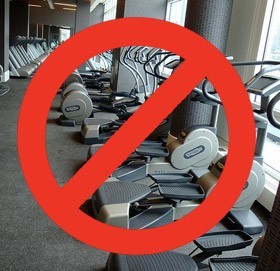Does Cardio Need To Be Part Of Your Exercise Routine?
 NO!!!!! is the short and sweet (or highly exclaimed) answer. To further qualify that answer, I want you to know that I mean “NO!!!!!!” in response to the long duration, low intensity type of activity most people call cardio. Activities like jogging or running (especially indoors, with fluorescent lighting, bad air circulation, on a treadmill), the stair master, the elliptical, the rowing machine….
NO!!!!! is the short and sweet (or highly exclaimed) answer. To further qualify that answer, I want you to know that I mean “NO!!!!!!” in response to the long duration, low intensity type of activity most people call cardio. Activities like jogging or running (especially indoors, with fluorescent lighting, bad air circulation, on a treadmill), the stair master, the elliptical, the rowing machine….
We should definitely exercise our hearts on a regular basis. The best way is through relatively short yet high intensity intervals (HIIT – High Intensity Interval Training) would be one way. Another way is through performing your regular workout with shorter rest periods between sets as Vince Gironda advocated for decades.
The beauty of working your heart this way is it requires no additional equipment than you already use. No need to buy bulky treadmills, stair masters, ellipticals that collect dust and cost an arm and a leg. The answer is within you, like with all other things. The simplest way to start, especially of you consider yourself to be a “runner” is to do short 8 – 10 second sprints with 30 – 60 seconds of rest between sprints. Besides getting an excellent cardiovascular workout, you’ll be working your muscles more intensely, turning on your internal furnace which will melt the fat off your body. Just take a look at the difference in sprinters and long distance runners. The statistics also show that athletes working primarily aerobically (marathon runners, rowers, cross country skiers) die much younger than other athletes.
The way you’d incorporate higher quality cardiovascular work into your regular strength training workout is by reducing the rest periods. The heads up on that is to cut your regular weights in half (you’ll thank me later) and track your rest periods between sets and even exercises. If you can work your way down to 15 seconds of rest between exercises, your heart will be getting an excellent workout and again, the fat melting effect will also kick in. Since I promised no additional equipment needed, I’ll spare you the pitching of the latest and greatest stopwatch you could buy. The best way I found of keeping track of rest periods is by counting the number of breaths I take. After a quality set of rows, for example, your breathing rate will be anywhere from 3 seconds to 6 seconds. Which means working your way down to 5 inhalation/exhalations will be roughly 15 seconds. If, after your first set, you take roughly 6 seconds to inhale and exhale, you’d only rest for 2 and a half breaths before beginning your next set or exercise. You get the picture.
15 seconds of rest is a good place to be. You could obviously decrease that rest even more when you feel you’re ready to progress.
My caution is begin slowly. If you’re taking more than 60 seconds between sets (if your progress had halted, this would explain why) you’d first want to start there. Then reduce your rest to 45 seconds between sets when you feel ready, then down to 30 seconds and so on. Work at your own pace to make sure you can continue progressing.
Leave a comment below if you need a more detailed explanation.

